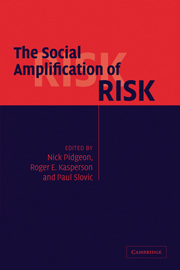Book contents
- Frontmatter
- Contents
- List of figures
- List of tables
- List of contributors
- Acknowledgments
- Introduction
- Part I Conceptual foundations
- Part II Risk signals and the mass media
- Part III Public perceptions and social controversy
- 9 The dynamics of risk amplification and attenuation in context: a French case study
- 10 Public response to Y2K: social amplification and risk adaptation: or, “how I learned to stop worrying and love Y2K”
- 11 The social dynamics of environmental risk perception: implications for risk communication research and practice
- 12 Understanding amplification of complex risk issues: the risk story model applied to the EMF case
- Part IV Risk ripples and stigma effects
- Part V Policy and management
- Bibliography
- Index
11 - The social dynamics of environmental risk perception: implications for risk communication research and practice
Published online by Cambridge University Press: 06 July 2010
- Frontmatter
- Contents
- List of figures
- List of tables
- List of contributors
- Acknowledgments
- Introduction
- Part I Conceptual foundations
- Part II Risk signals and the mass media
- Part III Public perceptions and social controversy
- 9 The dynamics of risk amplification and attenuation in context: a French case study
- 10 Public response to Y2K: social amplification and risk adaptation: or, “how I learned to stop worrying and love Y2K”
- 11 The social dynamics of environmental risk perception: implications for risk communication research and practice
- 12 Understanding amplification of complex risk issues: the risk story model applied to the EMF case
- Part IV Risk ripples and stigma effects
- Part V Policy and management
- Bibliography
- Index
Summary
Interest in risk communication has become increasingly widespread in recent years, attracting a global constituency of attention within government and industry alike. Starting, as it did, as an attempt to drive home the perceived wisdom of scientific risk assessments to unconvinced lay audiences, it has now diversified to encompass a number of wider objectives. As Baruch Fischhoff (1995, p. 138), in his recent review, concluded, whilst the starting-point of this shift may be parodied as “all we have to do is get the numbers right,” the current position amounts to “all we have to do is make (lay publics) partners.” Indeed, the emphasis on process issues: decision making, fairness, trust and “meaningful participation,” and ideas about democracy, have come to play a central role in both the research and policy development agendas (e.g. Chess et al. 1995; Renn, Webler, and Wiedemann 1995; Stern and Fineberg, 1996; Shell United Kingdom 1998; Department of Health 1998; United Kingdom Inter-departmental Liaison Group on Risk Assessment 1998b; Bennett and Calman 1999; House of Lords 2000).
Underlying these changes, a number of interconnected social and political developments looms large. We are witnessing times of rapid change, economic re-structuring, and globalization, featuring a huge expansion of media and electronic communication, and significant cultural fragmentation. According to current wisdom, these changes, in combination, have produced a politicization of risk issues, the emergence of the active consumer and a new propensity for “moral panics” (Beck 1992; Giddens 1991; Thompson 1998).
- Type
- Chapter
- Information
- The Social Amplification of Risk , pp. 262 - 285Publisher: Cambridge University PressPrint publication year: 2003
- 39
- Cited by



